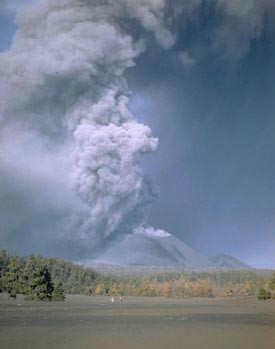Seven
Natural Wonders of the World:
Parícutin Volcano
Parícutin
is a cinder cone volcano in the Mexican state of
Michoacán, close to a lava-covered village of the same name.
Paricutín is part the Michoacán-Guanajuato Volcanic Field, which
covers much of west central Mexico.
Volcanism is a common part of the Mexican landscape. Parícutin is
merely the youngest of more than 1,400 volcanic vents that exist in
the Trans-Mexican Volcanic Belt and North America. The volcano is
unique in the fact that its formation was witnessed from its very
conception. Three people died as a result of lightning strikes
caused by the eruptions, but no deaths were attributed to the lava
or asphyxiation.
History

The volcano began
as a fissure in a cornfield owned by P'urhépecha farmer Dionisio
Pulido on February 20, 1943. Pulido, his wife, and their son all
witnessed the initial eruption of ash and stones first-hand as they
plowed the field.
Much of the volcano's growth occurred during its first year, while
it was still in the explosive pyroclastic phase. Nearby villages
Paricutín and San Juan Parangaricutiro were both buried in lava and
ash; the residents relocated to vacant land nearby.
At the end of this phase, after roughly one year, the volcano had
grown 336 meters tall. For the next eight years the volcano would
continue erupting, although this was dominated by relatively quiet
eruptions of lava that would scorch the
surrounding 25 km² of land.
The volcano's activity would slowly decline during this period
until the last six months of the eruption, during which violent and
explosive activity was frequent.
In 1952 the eruption ended and Parícutin went quiet, attaining a
final height of 424 metres above the cornfield from which it was
born. The volcano has been quiet since. Like most cinder cones,
Parícutin is a monogenetic volcano, which means that it
will never erupt again.
Discrepancy
in Elevation
There are
actually two different elevations attributed to Parícutin.
According to some sources, including the Smithsonian Global
Volcanism Program, the elevation of the volcano is 3000 meters
(10,397 feet). One web site has this elevation for both Parícutin
and nearby El Jorullo, but the actual altitude of El Jorullo is
much lower.
Other sources, including Peakbagger.com and Bartleby.com as well as
many maps along with GPS measurements on
Google Earth have the elevation of Paricutín at only 2,774 meters
(9,101 feet).
Reference / Image
Credits:
Wikipedia
1.
Viva Mexico
2. Smithsonian
National Museum of Natural History
3.
Free Web